Most ribbon-configuration controls are available from right-click menus. This topic details these controls as well as others for customizing the ribbon setup.
To return the ribbon to its default configuration, quit 3ds Max, delete both MaxModelingRibbon.Config.xml and MaxManaged.cui from the system UI path (be sure to make backup copies first), and restart.
Floating and Docking the Modeling Ribbon and its Panels
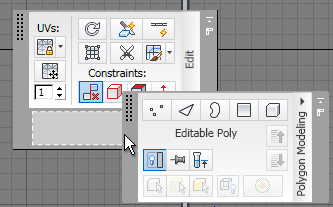
Docking one floating panel to another
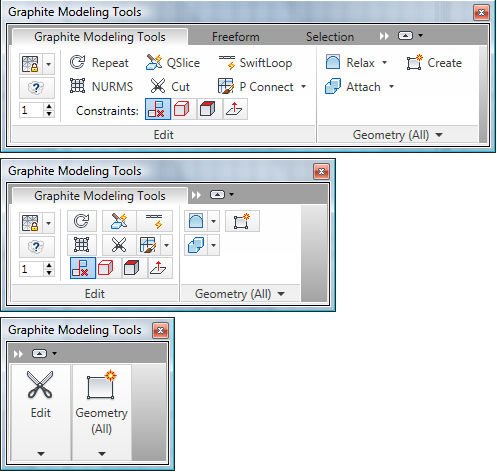
Top: Edit and Geometry (All) panels at full width, ...
Center: ... at medium width, and ...
Bottom: ... fully reduced
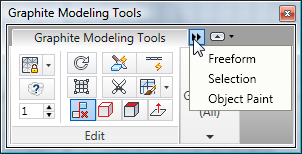
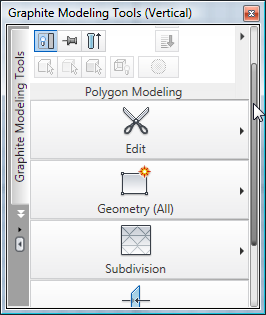
Vertical ribbon with scroll bar on right side

The Soft Selection and Slice Mode contextual panels have been moved closer to the left end of the ribbon.
In addition to the modeling tools provided by the panel buttons and other controls, the modeling ribbon provides interface-management functions in the form of buttons and a context-sensitive right-click menu.
Button-type ribbon controls let you expand panels, pin the expansions, and more; all are described in this section.
At the bottom or right side of every panel is the title bar; if Show Panel Titles is off, a thin bar takes its place. If the title bar contains a small arrowhead, that means it can be expanded to show additional controls. To expand the panel, click the title.
The panel expansion remains open as long the mouse cursor stays on it. To close it, simply move the mouse away.
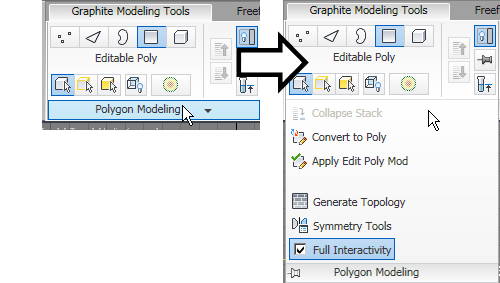
Left: Click the panel title bar ...
Right: ... to open the panel expansion.

 [pin/unpin panel expansion]
[pin/unpin panel expansion]At the left end of the title bar of an expanded panel is a small button with a pushpin icon (see preceding illustration). To “pin” the panel expansion, thus locking it open, click this button. To allow it to close, “unpin” it by clicking the button again.
 Return Panels to Ribbon
Return Panels to Ribbon Toggle Orientation
Toggle Orientation Minimize/Maximize
Minimize/MaximizeClick this button, found on the ribbon next to the tab titles, to toggle the ribbon between maximized and the active minimize option (see following).
Alternatively, if the Cycle Through All option is active (see following), clicking Minimize/Maximize activates the next option in this progression: maximized, minimized to panel buttons, minimized to panel titles, and minimized to tabs.
When the ribbon is maximized, most of its controls are visible; the rest are available on the expansion area of certain panels, indicated by a small arrowhead next to the panel title. Click the title to open the expansion.

To set the active minimize option, click the small arrow next to the Minimize/Maximize button and choose an option from the drop-down list:

In this mode, additional controls on some panels are available on the panel expansion, indicated by a small arrowhead next to the panel title when the panels are expanded. Click the title to open the expansion.

In this mode, each panel expands to show all controls automatically; no further expansion is available.

When you right-click the ribbon or a floating panel group, different commands and submenus appear, depending on where you click. Following is a comprehensive listing of available right-click-menu commands.
Toggles visibility of the ribbon tabs: Graphite Modeling Tools, Freeform, and Selection, and Object Paint.
When on, a panel title appears at the bottom or side of each panel (depending on orientation). When off, the panel titles are replaced by thin horizontal strips on the horizontal ribbon; you can drag these away from the ribbon to float the panels. However, on the vertical ribbon, turning of Show Panel Titles simply removes the title bars.
These commands are available on the ribbon right-click menu  Ribbon Configuration submenu for changing the ribbon configuration to better fit your workflow.
Ribbon Configuration submenu for changing the ribbon configuration to better fit your workflow.
Opens the Customize Ribbon dialog.
Opens a dialog for loading a saved ribbon-configuration file. These files use the .ribbon filename extension, and contain all ribbon-configuration data including orientation, maximize/minimize status, docked/floating/position/size status, tab and panel visibility, and so on.
In general, use Load Ribbon to load a custom configuration file you created with Save Ribbon (see following).
Opens a dialog for saving a ribbon-configuration file. These files use the .ribbon filename extension, and contain all ribbon-configuration data including orientation, maximize/minimize status, docked/floating/position/size status, tab and panel visibility, and so on.
If you typically change the ribbon configuration during a session or for different projects, use Save Ribbon to store each configuration in a different file and then restore a saved configuration with Load Ribbon (see preceding).
Restores the ribbon to the default settings as originally installed, including horizontal orientation, docked at the top of the interface, and minimized to panel titles. In addition, any ribbon elements you added, removed, or changed with Customize Ribbon (see preceding) are lost, so be sure to save the ribbon in a custom file before resetting it.